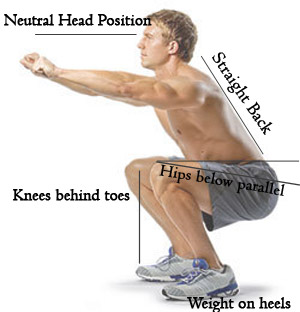Squats are essential to every human’s ability to move. They are the foundational exercise that promotes balance and mobility. When done correctly, squats will help improve knee stability and strengthen connective tissue. Simple form corrections can help eliminate knee pain.
They can be a great part of everybody’s exercise routine, as they strengthen and tone the whole body, help with weight loss and can even help with regular bowel movements.
But how often do I see squats done incorrectly. Either in my practice when asked a client to perform a functional squat I see poor form and biomechanics or I cringe when in a gym and see the squats perform by the majority of gym goers. The majority of people do them too quickly and don’t understand exactly what they are trying to achieve. Yes, they are hard and they get the blood pumping, so you just try and get them done as quickly as possible but when done correctly they can achieve so much for us.
It is a perfect reason they are known as the best functional exercise out there. They are what we have been doing since day dot, as our ancestors did many years ago.
The most common squats everybody does every day is going to the toilet. Unfortunately, the modern toilet has eliminated this movement. Other squats we do are getting up and down from a chair but the way people now get out of chairs is becoming less useful through our hips. As a result, very few people engage in high quality squats on a daily basis.
The many health benefits of squats include strengthening your butt (gluteus maximus, medius and minius) and thigh muscles (quadriceps, hamstrings, adductors), lengthening your calves and ankles and make you more stable on your feet (balance).
Other benefits of squats are:
• increased fat burning in the body from moving so many muscle groups in one movement;
• improved balance and mobility;
• enhances athletic ability, as the big prime movers of movement are strengthen you can generate more power and explosiveness into other areas of your life such as jumping, running;
• tones your abdominals and buttock
• improves your ability to remove waste from your body and have better bowel movements.
SQUAT BASIC 101
Most people when squatting lean too far forward and cannot keep the weight into their heels. This leads to them leaning forward stressing their low backs and putting more shearing forces through their knees and ending up with the biggest complaint from squats that they hurt my knees. Learning correct technique will solve many of these issues. Some key points to remember:
1. Stand with your feet just over shoulder width apart, toes straight or slightly turned out 15 degrees;
2. Keep your back in neutral position with core activated for the whole movement pattern, and your knees centred over your feet
3. Slowly hinge in the hips first and then bend your knees and ankles, lowering yourself until you reach a 90-degree angle with the chest up, pause for 1-2 seconds and then return to the starting position
4. Try and do 3 sets of 10-15 reps, 2-3 times per week and you will start to see the difference quickly.
Once you have mastered the Basic Squat, from there the possibilities are endless to you. If you start incorporating movement and flow to your routines your body will start to benefit and you will not cringe or moan every time you have to get up out of a chair.
A few examples of just body weight squat variations are:
• Cossack Squats;
• Bulgarian Split Squats;
• Overhead squats;
• Single leg pistol squats;
• Grok Squat;
• Sumo Squats;
• Goblet Squat;
• Incline Squats;
• Deck Squats;
• Skiers Squat;
• Twisting Squats;
• Figure Four Squat
These are just a few variations on top of your back and front squats.
Squats are one of those exercises you can do for a few minutes every single day, even without switching into your gym clothes. They can be done anywhere and anytime. It is just a matter of doing them and doing them correctly.
Here at Neurohealth, our practitioners are trained to assess, analyse and provide the proper movement patterns to this essentially foundational movement that is required by everyone. If you have any queries or would like to have your squat digitally analysed to see where your weakness is and were improvements can be made from basic squat movements, speak to the team at Neurohealth Chiropractic to help you out.




